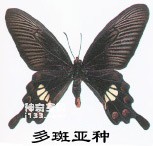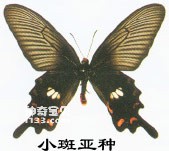The white spots on the hind wings of the red butterfly have various types such as small spots, multiple spots, large spots, and U-shaped spots.
Alias: red-bellied swallowtail butterfly, seven-star swallowtail butterfly, red-striped dawn butterfly, red-striped swallowtail butterfly.
The adult wingspan is 70 to 94 mm. The back of the body is black, with dense red hairs on the face, sides of the chest, and the end of the abdomen. The front and rear wings are black, with gray or tan on both sides of the veins. The middle, rear and sub-peripheral areas of the forewings of some individuals are light in color, or dark brown or tan. There are 3 to 5 white spots on the outside of the middle chamber of the hind wings, and those with 3 spots are arranged in small letters; the outer edge is wavy, and there are 6 to 7 pink or yellowish brown spots on the wing edges, mostly meniscus-shaped. The reverse side of the wings is similar to the front side, the hind wing spots are more obvious than the front side, and there is a red spot on the hip edge.

Host: Plants of the genus Aristolochia spp. in the family Aristolochiaceae.
Biology: Adults appear most frequently from July to August. They like to fly in mountainous and plain areas. They sometimes appear in gardens and appear in groups. The multispotted subspecies is distributed from Taiwan's flatlands to mountainous areas with an altitude of 1000 m. Adults can be seen throughout the year, with more species in spring and autumn. At an average temperature of 25°C, the egg stage lasts about 5 days, the larval stage lasts about 21 days, and the pupa stage lasts about 12 days. Adult beetles prefer to lay eggs on host plants with sufficient light. Eggs are mostly laid on the backs of leaves, stems or buds. The larvae are inactive and mostly inhabit the backs of leaves or stems. Mature larvae pupate on the stems of host plants, the backs of old leaves or on nearby plants. Adults fly slowly and are often seen flying among flowers on forest edges along roadsides in mountainous areas or visiting flowers to suck nectar.

Distribution: Hebei, Henan, Shaanxi, Jiangxi, Hunan, Zhejiang, Guangxi, Sichuan, Yunnan, Fujian, Hainan, Taiwan, Hong Kong; India, Myanmar, Thailand, Malaysia, Indonesia, Philippines and other countries.
This species is very similar to the female of the Papilion butterfly (the latter imitates the former). The main difference is the red markings on the outer edge of the hind wings. The red markings of this species are oblate, while that of the Papilion butterfly is crescent-shaped. In addition, there are no red hairs on the abdomen of the butterfly.
animal tags:
We created this article in conjunction with AI technology, then made sure it was fact-checked and edited by a Animals Top editor.